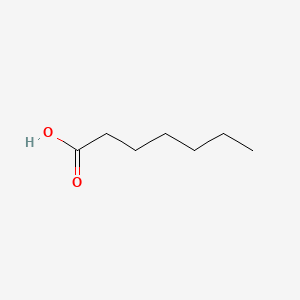| MeSH term | MeSH ID | Detail |
|---|---|---|
| Olfaction Disorders | D000857 | 17 associated lipids |
| Byssinosis | D002095 | 11 associated lipids |
| Mitochondrial Diseases | D028361 | 25 associated lipids |
HEPTANOIC ACID
HEPTANOIC ACID is a lipid of Fatty Acyls (FA) class. Heptanoic acid is associated with abnormalities such as Dehydration. The involved functions are known as Process, Anabolism, inhibitors, Oxidation and fatty acid oxidation. The related lipids are Heptanoates and undecanoic acid.
Cross Reference
Introduction
To understand associated biological information of HEPTANOIC ACID, we collected biological information of abnormalities, associated pathways, cellular/molecular locations, biological functions, related genes/proteins, lipids and common seen animal/experimental models with organized paragraphs from literatures.
What diseases are associated with HEPTANOIC ACID?
HEPTANOIC ACID is suspected in Dehydration and other diseases in descending order of the highest number of associated sentences.
Related references are mostly published in these journals:
| Disease | Cross reference | Weighted score | Related literature |
|---|
Possible diseases from mapped MeSH terms on references
We collected disease MeSH terms mapped to the references associated with HEPTANOIC ACID
PubChem Associated disorders and diseases
What pathways are associated with HEPTANOIC ACID
There are no associated biomedical information in the current reference collection.
PubChem Biomolecular Interactions and Pathways
Link to PubChem Biomolecular Interactions and PathwaysWhat cellular locations are associated with HEPTANOIC ACID?
There are no associated biomedical information in the current reference collection.
What functions are associated with HEPTANOIC ACID?
Related references are published most in these journals:
| Function | Cross reference | Weighted score | Related literatures |
|---|
What lipids are associated with HEPTANOIC ACID?
Related references are published most in these journals:
| Lipid concept | Cross reference | Weighted score | Related literatures |
|---|
What genes are associated with HEPTANOIC ACID?
There are no associated biomedical information in the current reference collection.
What common seen animal models are associated with HEPTANOIC ACID?
There are no associated biomedical information in the current reference collection.
NCBI Entrez Crosslinks
All references with HEPTANOIC ACID
Download all related citations| Authors | Title | Published | Journal | PubMed Link |
|---|---|---|---|---|
| Antebi A | The prepared mind of the worm. | 2005 | Cell Metab. | pmid:16054058 |
| LaPara TM et al. | Adaptations in bacterial catabolic enzyme activity and community structure in membrane-coupled bioreactors fed simple synthetic wastewater. | 2006 | J. Biotechnol. | pmid:16125815 |
| Okere IC et al. | Differential effects of heptanoate and hexanoate on myocardial citric acid cycle intermediates following ischemia-reperfusion. | 2006 | J. Appl. Physiol. | pmid:16141384 |
| Zhao G et al. | Rapid determination of short-chain fatty acids in colonic contents and faeces of humans and rats by acidified water-extraction and direct-injection gas chromatography. | 2006 | Biomed. Chromatogr. | pmid:16206138 |
| Shimshek DR et al. | Enhanced odor discrimination and impaired olfactory memory by spatially controlled switch of AMPA receptors. | 2005 | PLoS Biol. | pmid:16216087 |
| Buccellati C et al. | Pharmacological characterization of 2NTX-99 [4-methoxy-N1-(4-trans-nitrooxycyclohexyl)-N3-(3-pyridinylmethyl)-1,3-benzenedicarboxamide], a potential antiatherothrombotic agent with antithromboxane and nitric oxide donor activity in platelet and vascular preparations. | 2006 | J. Pharmacol. Exp. Ther. | pmid:16399881 |
| Chen R and LaPara TM | Aerobic biological treatment of low-strength synthetic wastewater in membrane-coupled bioreactors: the structure and function of bacterial enrichment cultures as the net growth rate approaches zero. | 2006 | Microb. Ecol. | pmid:16400538 |
| Zhang XH et al. | Testosterone restores diabetes-induced erectile dysfunction and sildenafil responsiveness in two distinct animal models of chemical diabetes. | 2006 | J Sex Med | pmid:16490018 |
| Maeda I et al. | The peroxisomal Acyl-CoA thioesterase Pte1p from Saccharomyces cerevisiae is required for efficient degradation of short straight chain and branched chain fatty acids. | 2006 | J. Biol. Chem. | pmid:16490786 |
| Bernini G et al. | Vascular reactivity in congenital hypogonadal men before and after testosterone replacement therapy. | 2006 | J. Clin. Endocrinol. Metab. | pmid:16492703 |
